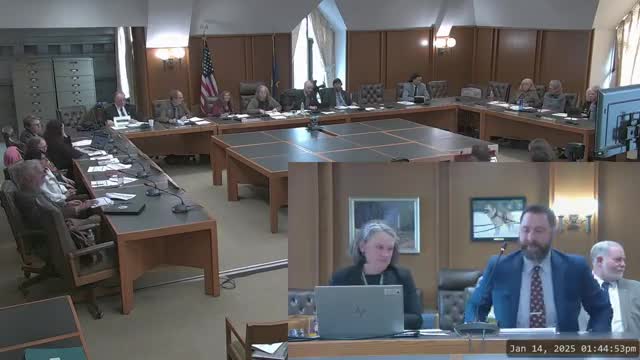State veterinarian briefs committee on animal disease response; H5N1 surveillance added for dairy
January 14, 2025 | Environment and Agriculture, House of Representatives, Committees , Legislative, New Hampshire
This article was created by AI summarizing key points discussed. AI makes mistakes, so for full details and context, please refer to the video of the full meeting. Please report any errors so we can fix them. Report an error »

Nate Harvey, assistant state veterinarian in the Department of Agriculture’s Division of Animal Industry, told the House Environment and Agriculture Committee that the division’s mission is to prevent and control contagious and infectious diseases of livestock and poultry for public‑health and economic protection.
Harvey outlined the division’s core activities: disease outbreak investigations, diagnostic sample submission and coordination with the New Hampshire Veterinary Diagnostic Laboratory, regulatory oversight of animal movements, and targeted programs such as the Animal Population Control Program. He said the division performs routine surveillance testing, responds to complaints and conducts trace‑backs where needed.
Harvey gave a detailed update on highly pathogenic avian influenza (HPAI, H5N1). He said the virus has caused extensive losses in the poultry sector nationwide and, since April of the prior year, has been detected in U.S. dairy cattle in multiple states with viral RNA found at high levels in raw milk. Harvey said the division is coordinating closely with the Department of Health and Human Services and USDA on surveillance and intends to implement a state milk monitoring program: bulk tank and silo sampling to check for the virus and to detect any potential local presence early.
He told members that wildlife contacts and interstate animal movements can spread certain diseases and urged that the public report suspicious dead wildlife to Fish and Game first; Fish and Game will work with the Agriculture division and call it in where warranted. The division also inspects livestock dealers, poultry dealers and operations such as swine garbage feeders, and Harvey emphasized that pork producers must not feed prohibited wastes that could introduce foreign animal disease.
Harvey said the division recently moved to an electronic animal movement and case‑management system to improve traceability; the system has already revealed higher-than-expected volumes of dog and cat transfers. He also described the department’s effort to collect and test milk samples should H5N1 surveillance be required or requested by federal partners.
Harvey said resources are a continuing challenge: the division is meeting routine responsibilities while also increasing disease surveillance and response capacity when unexpected threats such as H5N1 in dairy emerge.
Harvey outlined the division’s core activities: disease outbreak investigations, diagnostic sample submission and coordination with the New Hampshire Veterinary Diagnostic Laboratory, regulatory oversight of animal movements, and targeted programs such as the Animal Population Control Program. He said the division performs routine surveillance testing, responds to complaints and conducts trace‑backs where needed.
Harvey gave a detailed update on highly pathogenic avian influenza (HPAI, H5N1). He said the virus has caused extensive losses in the poultry sector nationwide and, since April of the prior year, has been detected in U.S. dairy cattle in multiple states with viral RNA found at high levels in raw milk. Harvey said the division is coordinating closely with the Department of Health and Human Services and USDA on surveillance and intends to implement a state milk monitoring program: bulk tank and silo sampling to check for the virus and to detect any potential local presence early.
He told members that wildlife contacts and interstate animal movements can spread certain diseases and urged that the public report suspicious dead wildlife to Fish and Game first; Fish and Game will work with the Agriculture division and call it in where warranted. The division also inspects livestock dealers, poultry dealers and operations such as swine garbage feeders, and Harvey emphasized that pork producers must not feed prohibited wastes that could introduce foreign animal disease.
Harvey said the division recently moved to an electronic animal movement and case‑management system to improve traceability; the system has already revealed higher-than-expected volumes of dog and cat transfers. He also described the department’s effort to collect and test milk samples should H5N1 surveillance be required or requested by federal partners.
Harvey said resources are a continuing challenge: the division is meeting routine responsibilities while also increasing disease surveillance and response capacity when unexpected threats such as H5N1 in dairy emerge.
View full meeting
This article is based on a recent meeting—watch the full video and explore the complete transcript for deeper insights into the discussion.
View full meeting
